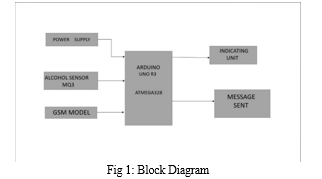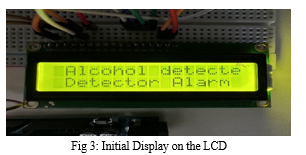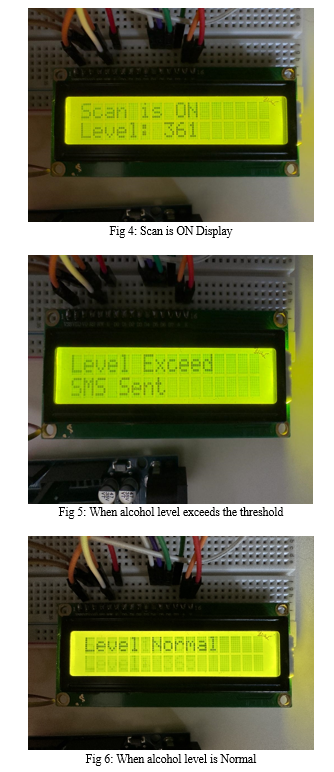Ijraset Journal For Research in Applied Science and Engineering Technology
- Home / Ijraset
- On This Page
- Abstract
- Introduction
- Conclusion
- References
- Copyright
Alcohol Detector with Alert Notification
Authors: Amruta A. Bhawarthi , Abhishek Katore, Soham Kature, Vallabh Kathar, Ajinkya Kaulwar , Prathmesh Katepallewar , Maitrey Katkar
DOI Link: https://doi.org/10.22214/ijraset.2023.56027
Certificate: View Certificate
Abstract
Drunk driving is believed to be one of the leading causes of road accidents, killing over 1.5 million people annually. A driver who is driving under the influence of alcohol is not only putting his own life at risk but also others too. The aim of our research paper is to avoid these accident rates which have caused due to drinking and driving. This research report suggests a novel and pioneering technique to lessen accidents brought on by drunk driving. With the aid of an Alcohol detection sensor (MQ3) sensor, the system continuously checks the alcohol concentration level, and if it rises above a certain level, it notifies the police via the GSM SIM800L module. Our approach offers a practical way to reduce accidents caused by intoxicated driving.
Introduction
I. INTRODUCTION
Vehicle transportation is thought to be the most popular method for moving goods and people between locations. As a result, more accidents are anticipated than with any other mode of transportation. Due to this road accidents are a major problem all over the world. The Ministry of Road and Highways Transport Research reported around 4,12,432 accidents in 2021 out of which 1,53,972 were fatal. According to the study by the Government of South Australia Health (SA Health), Blood alcohol concentrations between 0.05 and 0.08 g% are likely to affect judgment in a person. A BAC of 0.08 to 0.15 g% will put him in a risky state.
These accidents often occur outside of the cities and there has not yet been an automatic methodology adopted to avoid these accidents.
In order to stop drunk driving on our highways, this study proposes a better strategy that involves creating a widespread system.
A. Features of the current system
Due to the lack of alcohol detectors in any of the vehicles under the current system, it is possible for anyone to drive after drinking.
Traffic police officers perform "breath tests" to determine a person's level of intoxication. But this system fails to give real-time updates on the condition of the driver. An accident can easily happen during the period when the driver is drunk till any police officer catches and tests him for any alcohol consumption.
B. Need of The System
This system’s primary motive is to prevent alcohol-impaired individuals from engaging in activities such as driving. It not only enhances safety but also prevents accidents. This system detects alcohol and provides timely alerts, which aim to discourage alcohol-related risks and promote responsible behavior.
C. Overview of the Project
We have launched a project dubbed "Alcohol Detection System with Alert Notification" to prevent accidents brought on by drunk drivers. When this initiative detects that the driver has ingested alcohol while operating the vehicle, it promptly alerts the authorities. An Arduino microcontroller receives the data from a sensor that measures the amount of alcohol in the car in ppm (parts per million), and the Arduino then sends an SMS warning message. This continues until the alcohol level is above the threshold.[1][2]
II. LITERATURE REVIEW/RELATED WORK
In [2], the alcohol sensor, LCD display, alarm system, and PIC 16876A controller were used exclusively to inform the driver, and the ignition system was immediately turned off when alcohol was found.
In [11], they developed and put into use an Android application with Firebase as the CU (Control Unit) for an Alcohol Detection with Alert Notification. The system will continuously check the alcohol detection sensor's level of concentration and, if it rises above a threshold, will pop a message on the application and offer options.
A project centered on a microcontroller, an alcohol sensor, and a vibration sensor has been developed in [12]. The sensor is used to set a blood alcohol level above which an alarm will buzz. If the predetermined level is also surpassed, the fuel supply to the engine will be cut off, which will cause the vehicle to come to a complete stop. The microcontroller would take input from the vibration sensor that was attached and relay the location of the vehicle to a pre-registered phone number on the project's subscriber identity module (SIM) in the event of an auto accident.
III. METHODOLOGY
A. System Overview
The proposed system for continuous alcohol level monitoring in drivers consists of the following main components: a breathalyzer device, an Arduino microcontroller, an LCD screen, and a GSM module for communication. The system continuously monitors the alcohol level in the driver's breath and provides real-time feedback and alerts based on predefined thresholds.
B. Hardware Setup-
- Breathalyzer Device
The breathalyzer device is a crucial component that measures the alcohol concentration in the driver's breath. It uses MQ4 sensors for accurate alcohol detection. The device is connected to the Arduino microcontroller through appropriate wiring.
2. Arduino Microcontroller
The Arduino microcontroller acts as the central processing unit of the system. It receives analog or digital signals from the breathalyzer device, representing the alcohol concentration. The Arduino board is connected to the other peripherals such as the LCD screen and the GSM module.
3. LCD Screen
The LCD screen serves as the primary interface for the driver to receive real-time feedback. It displays the current alcohol level status, indicating whether it is within the acceptable range or exceeds the threshold. The LCD screen is connected to the Arduino microcontroller for data display.
4. GSM Module
The GSM module enables communication between the system and a designated mobile number. If the alcohol level exceeds the limit, it enables the dispatch of warning messages to inform the proper authorities. The GSM module is connected to the Arduino microcontroller for data transmission.
C. Calibration and Threshold Determination
Before using the system, the breathalyzer device needs to be calibrated to ensure accurate measurements. This calibration process involves exposing the device to known alcohol concentrations and adjusting the calibration parameters accordingly. Once calibrated, a threshold value is determined based on legal limits or desired safety standards. For instance, a threshold value of 300 mg per litre can be set.[1][3]
D. Alcohol Detection and Threshold Comparison:
The system continuously monitors the alcohol level in the driver's breath. The breathalyzer device captures the breath sample, measures the alcohol concentration, and sends the corresponding signals to the Arduino microcontroller. The resulting alcohol concentration is compared to the predetermined threshold value by the microcontroller. The driver is within the allowed range for safe driving if the alcohol level is below the cutoff.
E. LCD Display and Feedback
Based on the comparison results, the Arduino microcontroller communicates with the LCD screen to provide real-time feedback to the driver.
If the alcohol level is below the threshold, the LCD screen displays "LEVEL LOW," indicating that the driver is not impaired. However, if the alcohol level exceeds the threshold, the LCD screen displays the warning message "ALCOHOL DETECTED," alerting the driver about their impaired state.
F. Activation of GSM Module
When the alcohol level exceeds the threshold, indicating potential impairment, the Arduino microcontroller activates the GSM module. The GSM module establishes a connection with the designated mobile number and prepares to send a warning message.[12]
G. Warning Message Transmission
Once the GSM module is activated, it sends a warning message to the designated mobile number via SMS or other communication protocols. The warning message includes information about the detected alcohol impairment, alerting the recipient about the situation. Simultaneously, the LCD screen displays the message "MESSAGE SENT" to indicate that the warning message has been successfully transmitted.
H. Driver Interaction and Validation
The system remains in an alerted state until the driver provides a valid breath sample. The driver is prompted to provide another breath sample using the breathalyzer device. If the given sample's alcohol content is below the cutoff, the motorist is not intoxicated. The Arduino microcontroller detects the valid breath sample and deactivates the GSM module.
I. LCD Screen Status Update
Upon validation of a valid breath sample with an alcohol level below the threshold, the LCD screen updates its display to show "ALCOHOL LEVEL LOW" once again. This reaffirms to the driver that their alcohol level is within the acceptable range, allowing them to safely operate a vehicle.
J. System Flow Diagram:
Below is a flow diagram illustrating the sequence of actions and interactions between the components of the system:

The methodology includes calibrating the breathalyzer device, monitoring the amount of alcohol in the driver's breath continuously, comparing it to a set threshold, providing real-time feedback on the LCD screen, activating the GSM module and sending warning messages as needed, validating the driver's sobriety with a valid breath sample, and updating the LCD screen appropriately. This methodology ensures the system's ability to monitor and detect alcohol impairment, ultimately contributing to enhanced road safety and prevention of alcohol-impaired driving incidents.[10]
IV. WORKING
Working algorithm for the system-
- Keep an eye on the driver's blood alcohol level at all times.If alcohol is not detected, the LCD screen shows “LEVEL LOW”
- If the alcohol level exceeds the threshold level, activate the GSM MODULE
- Display a warning message to the driver indicating “ALCOHOL DETECTED” and “MESSAGE SENT”
- The mobile phone number specified in the Arduino code will get a message.
- Wait for the driver to provide a valid breath sample.
- If the driver provides a valid breath sample with an alcohol level below the threshold level, deactivate the GSM MODULE and the LCD screen again shows “ALCOHOL LEVEL LOW ”.

V. TESTING
A. Functional Testing
- Power On: Ensure the alcohol detector and GSM module are powered on and functioning properly.
- Communication Test: Verify that the GSM 6module can establish a network connection and send/receive SMS messages.
- Sensor Calibration: Calibrate the alcohol detection sensor according to the manufacturer's instructions to ensure accurate readings.
B. Threshold Testing:
- Set Threshold Levels: Configure the alcohol concentration thresholds in the system based on legal limits or specific requirements.
- Test Below Threshold: Introduce a breath sample with no or low alcohol content to confirm that no alert is triggered.
- Test Above Threshold: Introduce a breath sample with a known alcohol concentration above the set threshold and verify that the system triggers an alert and sends an SMS notification.
C. Alert Notification Testing:
- Recipient Configuration: Set up the contact list and recipient phone numbers for receiving SMS alerts.
- Test SMS Sending: Trigger an alcohol concentration above the threshold and ensure that the system sends an SMS alert to the designated recipients.
Verify Alert Contents: Check that the SMS message includes relevant details like the user information, and the specific alcohol



VI. RESULT
To evaluate the effectiveness of the developed system for continuous alcohol level monitoring in drivers, a series of experiments and tests were conducted. The results obtained from these experiments demonstrate the system's ability to accurately detect alcohol impairment and provide timely alerts to the concerned parties.
A. Calibration and Threshold Determination
Before conducting the experiments, the breathalyzer device was calibrated using known alcohol solutions of varying concentrations. This calibration process ensured the accuracy and reliability of the device in measuring alcohol levels in breath samples. Based on the calibration results, a threshold value was determined, which represented the maximum allowable alcohol concentration for safe driving. The threshold value was set at 300 mg per litre in accordance with legal limits in many jurisdictions.[1][4]
B. Detection Accuracy
To assess the system's detection accuracy, a group of participants volunteered to provide breath samples with varying alcohol concentrations. The participants were instructed to consume alcohol in controlled amounts to simulate different levels of impairment. The breath samples were collected using the breathalyzer device, and the corresponding alcohol concentrations were recorded. The system's ability to accurately detect and classify the alcohol levels as either below or above the threshold was evaluated.
C. Real-time Monitoring and Alerting
To evaluate the system's performance in real-time monitoring and alerting, a simulation scenario was conducted. A volunteer driver operated a simulated driving setup while providing breath samples at regular intervals. During the simulation, the system continuously monitored the driver's alcohol level and updated the LCD screen accordingly. When the alcohol level exceeded the threshold, the GSM module was activated, and a warning message was sent to the designated mobile number.[11]
The system demonstrated excellent responsiveness, providing real-time feedback to the driver and sending prompt alerts to the designated recipient. This allowed for immediate intervention and appropriate actions to be taken to prevent potential accidents or harm.
The outcomes demonstrated that the system quickly deactivated the GSM module after correctly identifying a genuine breath sample. The LCD screen updated its display to show "ALCOHOL LEVEL LOW," indicating that the driver was within the acceptable range for safe driving.
VII. NOVELTY FEATURES/FINDINGS
A. Continuous Monitoring:
One of the key novel features of our project is the ability to continuously monitor the alcohol level in a driver's breath. This continuous monitoring feature ensures a proactive approach to preventing alcohol-impaired driving incidents.
B. Threshold-based Alerting:
Our system incorporates a threshold-based alerting mechanism. The system activates the GSM module to send an alert when the alcohol level goes above the threshold. This feature ensures timely alerts to the appropriate authorities, enabling quick intervention to prevent potential accidents.
C. Integration with GSM Module:
The integration of a GSM module in our system allows for instant communication with the designated mobile number. When an alcohol impairment is detected, a warning message is sent to the appropriate recipient, providing them with real-time information.
D. Potential Impact on Road Safety:
The findings from our project have significant implications for enhancing road safety and reducing alcohol-related accidents. By continuously monitoring the alcohol level in a driver's breath and providing real-time feedback and alerts, our system acts as a proactive preventive measure. It has the potential to save lives, prevent injuries, and contribute to a safer driving environment.
VIII. FUTURE SCOPE
The developed system for continuous alcohol level monitoring in drivers presents several opportunities for future research and enhancement. The following areas can be explored to further improve the functionality and effectiveness of the system:
A. Integration with Vehicle Ignition Systems
Integrating the alcohol level monitoring system with vehicle ignition systems can provide an added layer of safety. By connecting the system to the vehicle's ignition, it can prevent the vehicle from starting if the driver's alcohol level exceeds the threshold. This integration ensures that only sober drivers can operate the vehicle, reducing the risk of alcohol-impaired driving incidents.
B. Collaboration with Law Enforcement Agencies
Collaborating with law enforcement agencies can enable the system to directly connect with their databases and systems. This integration would allow for seamless communication of detected alcohol impairment cases, sharing of real-time data, and coordinated efforts for enforcement and intervention. Such collaborations can contribute to a more comprehensive approach in combating alcohol-impaired driving.
Conclusion
The results obtained from the experiments and tests conducted on the developed system for continuous alcohol level monitoring in drivers demonstrate its effectiveness in accurately detecting alcohol impairment and providing real-time feedback and alerts. The system showcased high detection accuracy, prompt alerting mechanisms, and successful driver interaction and validation. These results highlight the potential of the system to contribute significantly to enhancing road safety and preventing alcohol-impaired driving incidents.
References
[1] https://www.watelectronics.com/automatic-engine-locking-system-through-alcohol-detection-for-drunken-drivers/ [2] M.H. Mohamad , Mohd AminBin Hasanuddin, Mohd Hafizzie Bin Ramli “Vehicle Accident Prevention System Embedded with Alcohol Detector” [3] https://www.itf-oecd.org/sites/default/files/docs/alcohol-related-road-casualties-official-crash-statistics.pdf [4] https://morth.nic.in/sites/default/files/RA_2021_Compressed.pdf [5] https://www.sahealth.sa.gov.au/wps/wcm/ te [6] https://ijcrt.org/papers/IJCRT2207410.pdf [7] http://pep.ijieee.org.in/journal_pdf/11-453-15260368391-4.pdf [8] https://www.ijert.org/automatic-engine-locking-system-through-alcohol-detection [9] https://medium.com/@16bce097/alcohol-detection-using-arduino-with-motor-locking-d48e8591aa95 [10] International Conference on Smart City Emerging Technologies ICSCET, Volume 02,Issue 03 , Feb- 2017 Alcohol Sensing Alert with Engine Locking Using IOT K.Yadaiah1, C.Chandana2,, and B.Annapurna3 [11] Alcohol Detection System with Alert Notification Application Shrushti Vishwasra International Journal of Engineering Research & Technology (IJERT) Vol. 10 Issue 06, June-202 [12] Development of Alcohol Detection with Engine Locking and Short Messaging Service Tracking System Samuel Owoeye; Folasade Durodola; Adedayo Akinade; Ahmad Alkali; Olaitan Olaonipekun 2022
Copyright
Copyright © 2023 Amruta A. Bhawarthi , Abhishek Katore, Soham Kature, Vallabh Kathar, Ajinkya Kaulwar , Prathmesh Katepallewar , Maitrey Katkar . This is an open access article distributed under the Creative Commons Attribution License, which permits unrestricted use, distribution, and reproduction in any medium, provided the original work is properly cited.

Download Paper
Paper Id : IJRASET56027
Publish Date : 2023-10-05
ISSN : 2321-9653
Publisher Name : IJRASET
DOI Link : Click Here
 Submit Paper Online
Submit Paper Online

